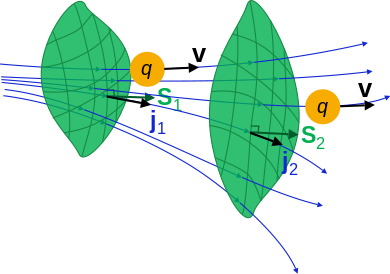What does continuity equation mean?
Definitions for continuity equation
con·ti·nu·ity equa·tion
This dictionary definitions page includes all the possible meanings, example usage and translations of the word continuity equation.
Wikipedia
Continuity equation
A continuity equation or transport equation is an equation that describes the transport of some quantity. It is particularly simple and powerful when applied to a conserved quantity, but it can be generalized to apply to any extensive quantity. Since mass, energy, momentum, electric charge and other natural quantities are conserved under their respective appropriate conditions, a variety of physical phenomena may be described using continuity equations. Continuity equations are a stronger, local form of conservation laws. For example, a weak version of the law of conservation of energy states that energy can neither be created nor destroyed—i.e., the total amount of energy in the universe is fixed. This statement does not rule out the possibility that a quantity of energy could disappear from one point while simultaneously appearing at another point. A stronger statement is that energy is locally conserved: energy can neither be created nor destroyed, nor can it "teleport" from one place to another—it can only move by a continuous flow. A continuity equation is the mathematical way to express this kind of statement. For example, the continuity equation for electric charge states that the amount of electric charge in any volume of space can only change by the amount of electric current flowing into or out of that volume through its boundaries. Continuity equations more generally can include "source" and "sink" terms, which allow them to describe quantities that are often but not always conserved, such as the density of a molecular species which can be created or destroyed by chemical reactions. In an everyday example, there is a continuity equation for the number of people alive; it has a "source term" to account for people being born, and a "sink term" to account for people dying. Any continuity equation can be expressed in an "integral form" (in terms of a flux integral), which applies to any finite region, or in a "differential form" (in terms of the divergence operator) which applies at a point. Continuity equations underlie more specific transport equations such as the convection–diffusion equation, Boltzmann transport equation, and Navier–Stokes equations. Flows governed by continuity equations can be visualized using a Sankey diagram.
Wikidata
Continuity equation
A continuity equation in physics is an equation that describes the transport of a conserved quantity. Since mass, energy, momentum, electric charge and other natural quantities are conserved under their respective appropriate conditions, a variety of physical phenomena may be described using continuity equations. Continuity equations are a stronger, local form of conservation laws. For example, it is true that "the total energy in the universe is conserved". But this statement does not immediately rule out the possibility that energy could disappear from Earth while simultaneously appearing in another galaxy. A stronger statement is that energy is locally conserved: Energy can neither be created nor destroyed, nor can it "teleport" from one place to another—it can only move by a continuous flow. A continuity equation is the mathematical way to express this kind of statement. Continuity equations more generally can include "source" and "sink" terms, which allow them to describe quantities which are often but not always conserved, such as the density of a molecular species which can be created or destroyed by chemical reactions. In an everyday example, there is a continuity equation for the number of living humans; it has a "source term" to account for people giving birth, and a "sink term" to account for people dying.
Numerology
Chaldean Numerology
The numerical value of continuity equation in Chaldean Numerology is: 4
Pythagorean Numerology
The numerical value of continuity equation in Pythagorean Numerology is: 9
Translation
Find a translation for the continuity equation definition in other languages:
Select another language:
- - Select -
- 简体中文 (Chinese - Simplified)
- 繁體中文 (Chinese - Traditional)
- Español (Spanish)
- Esperanto (Esperanto)
- 日本語 (Japanese)
- Português (Portuguese)
- Deutsch (German)
- العربية (Arabic)
- Français (French)
- Русский (Russian)
- ಕನ್ನಡ (Kannada)
- 한국어 (Korean)
- עברית (Hebrew)
- Gaeilge (Irish)
- Українська (Ukrainian)
- اردو (Urdu)
- Magyar (Hungarian)
- मानक हिन्दी (Hindi)
- Indonesia (Indonesian)
- Italiano (Italian)
- தமிழ் (Tamil)
- Türkçe (Turkish)
- తెలుగు (Telugu)
- ภาษาไทย (Thai)
- Tiếng Việt (Vietnamese)
- Čeština (Czech)
- Polski (Polish)
- Bahasa Indonesia (Indonesian)
- Românește (Romanian)
- Nederlands (Dutch)
- Ελληνικά (Greek)
- Latinum (Latin)
- Svenska (Swedish)
- Dansk (Danish)
- Suomi (Finnish)
- فارسی (Persian)
- ייִדיש (Yiddish)
- հայերեն (Armenian)
- Norsk (Norwegian)
- English (English)
Word of the Day
Would you like us to send you a FREE new word definition delivered to your inbox daily?
Citation
Use the citation below to add this definition to your bibliography:
Style:MLAChicagoAPA
"continuity equation." Definitions.net. STANDS4 LLC, 2025. Web. 23 Feb. 2025. <https://www.definitions.net/definition/continuity+equation>.







Discuss these continuity equation definitions with the community:
Report Comment
We're doing our best to make sure our content is useful, accurate and safe.
If by any chance you spot an inappropriate comment while navigating through our website please use this form to let us know, and we'll take care of it shortly.
Attachment
You need to be logged in to favorite.
Log In